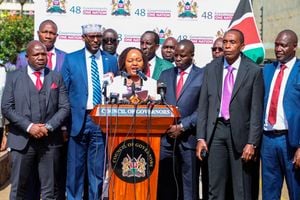
East Africa has been hit by internet disruptions since last weekend, resulting from a cut in an underwater cable near the Mtunzini landing station.
East Africa has been hit by internet disruptions since last weekend, resulting from a cut in an underwater cable near the Mtunzini landing station, 45 kilometres north of the South African port city of Durban. The break affected the Seacom and East Africa Submarine Cable System (EASsy) subsea cable systems, which both land in Mtunzini.
Cloudflare Radar reported that traffic dropped by 10-25 per cent in Kenya, Uganda, Madagascar and Mozambique and a third in Rwanda, Malawi and Tanzania.
The latest disruption is the second major one on the Eastern African coastline in the year. Cloudflare Radar reported that, on February 24, the Seacom/Tata cable was one of three that run through the Red Sea that was damaged. They are likely to have been cut by the anchor of the Rubymar, a cargo ship damaged by a ballistic missile lobbed by Yemen’s Houthi rebels on February 18. These cable cuts impacted several countries in eastern Africa, including Tanzania, Kenya and Uganda. More troubling, it is said, by the time SEACOM and EASsy went down on Sunday, these Red Sea cables remained unrepaired—possibly because the waters are still dangerous.
Underwater cables
These disruptions point to the perils of our region’s reliance on underwater cables for internet connectivity and the vulnerabilities posed by security crises—and turbulent weather in climate change-ravaged times. Additionally, we are closing in on the expiry dates of several of the cables that serve the region. Underwater cables have a life expectancy of 25 years. SEACOM landed in Mtunzini in 2009 and EASsy in 2010. Over the next 10 to 15 years, many of them will have to be replaced.
Although the world internet is still primarily connected by underwater cables, its time could be up. They are too vulnerable to all sorts of disruption, costly to build and, as with the damaged cables in the Red Sea, can be difficult to disrepair.
The future is where Elon Musk has already gone with his Starlink—low Earth Orbit (LEO) satellites beaming internet services down from space.
Leo offers many strategic advantages for East Africa. For one, the region would build an internet system which is less exposed to external factors beyond its control. A ship destroyed by Houthi missiles will not cut the system’s cable, if only there is none to cut. Additionally, the Israel-Gaza war could spiral and engulf most of the Middle East and the Horn of Africa, and we need to hedge against that likelihood.
Secondly, the East African Community is a platform that lends itself well to pooling resources to build an Afrika Mashariki SatNet. It will provide greater internet stability for EAC hinterland countries like Rwanda, Uganda, Burundi and South Sudan.
The bigger problem will be moving beyond opportunity to making it a reality. Half of the EAC members might not have the imagination or the commitment to gather up the money to invest in an Afrika Mashariki SatNet. The rest can start, and bring them on board later when they are ready.
Innovative colonialists
We can also find a solution from a problematic part of our history; European, especially British, colonialism. Hate them, but the British were particularly innovative colonialists. Its colonial enterprise gave the world its first modern public-private partnership (PPP). In places where it didn’t have sufficient capacity, colonial Britain sub-contracted chartered companies, which used private armies (among the first private security and mercenary companies) to control and expand trade in their dominions. In some areas, the companies went first, and then the colonial bureaucrats and representatives of the crown followed.
The most storied of them was the East India Company (EIC) which was formed to trade in the Indian Ocean region and Asia. The EIC was the one that conquered large parts of the Indian subcontinent and colonised parts of Southeast Asia and Hong Kong. Reportedly, at its peak, it was the largest corporation in the world and had a military force of about 260,000 soldiers.
In East Africa, the Imperial British East Africa Company (IBEAC) did the same thing. Building Afrika Mashariki SatNet could be our great multi-nation PPP project, with the companies coming on board being given privileges close to what IBEAC had. This balance of power would be necessary to shield them against predation.
With firms like Safaricom becoming the first in East Africa to become billion-US-dollar revenue companies, and banks like Equity Bank growing ever fatter, in Kenya, we are seeing the rise of companies that can throw some serious money at this. In Tanzania, Uganda and Rwanda, we also have reasonably deep-pocketed banks, cement makers, brewers and telcos.
These companies could create a consortium, the East African Construction Corporation (EACC), then let loose to take us to the sky. Logically, it also means that one of the countries will have to be an East African Digital Hegemon, offering leadership and, where necessary, bulldozing the “spoiler” nations.
I am also seduced by another bonus that a low earth orbit satellite-based East African internet offers—it won’t be easy for a single madman who sprouts in an East African state house to send soldiers to seize the network.
Mr Onyango-Obbo is a journalist, writer and curator of the “Wall of Great Africans”. @cobbo3










